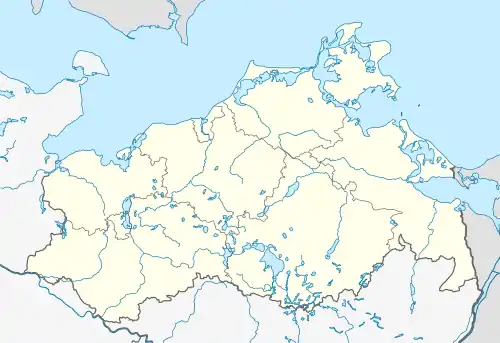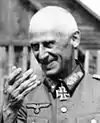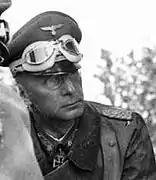| 3rd Panzer Army | |
|---|---|
| 3. Panzerarmee | |
| Active | 16 November 1940 – 3 May 1945 |
| Country | |
| Branch | Army (Wehrmacht ) |
| Type | Panzer |
| Role | Armoured warfare |
| Size | Army |
| Engagements | |

Pz Corps
12th Army
Tank Corps
Cav Corps
Red – Soviet forces, Orange – British forces, Green – U.S. forces, Grey – German forces
Sources: Tieke – p. 447, Allied Situation Map, Ustinow – Map 158
(1) – U.S. 84th Infantry Division, Bold units are 3rd Panzer Army
The 3rd Panzer Army (German: 3. Panzerarmee) was a German armoured formation during World War II, formed from the 3rd Panzer Group on 1 January 1942.
3rd Panzer Group
The 3rd Panzer Group (German: Panzergruppe 3) was formed on 16 November 1940. It was a constituent part of Army Group Centre and participated in Operation Barbarossa and fought in the Battle of Moscow in late 1941 and early 1942. Later it served in Operation Typhoon, where it was placed under operational control of the Ninth Army. Panzergruppe 3 was retitled the 3rd Panzer Army on 1 January 1942.
Orders of battle
At the start of Operation Barbarossa the Group consisted of the XXXIX and LVII Army Corps (mot.).
.jpg.webp)
2 October 1941
Part of Army Group Centre.
- Commander: Colonel General Hermann Hoth
- Chief of Staff: Colonel Walther von Hünersdorff
- XLI Motorized Corps under General of Panzer Troops Georg-Hans Reinhardt
- 1.Panzer-Division under Lieutenant General Friedrich Kirchner
- 36.Infanterie-Division (Mot.) under Lieutenant General Otto-Ernst Ottenbacher
- LVI Motorized Corps under General of Panzer Troops Ferdinand Schaal
- 6.Panzer-Division under Major General Franz Landgraf
- 7.Panzer-Division under Major General Hans Freiherr von Funck
- 14.Infanterie-Division (Mot.) under Major General Friedrich Fürst
- VI Corps under General of Engineers Otto-Wilhelm Förster
- 6.Infanterie-Division under Lieutenant General Helge Auleb
- 26.Infanterie-Division under Major General Walter Weiß
- 110.Infanterie-Division under Lieutenant General Ernst Seifert
3rd Panzer Army was formed by redesignating 3rd Panzer Group on 1 January 1942.
In March 1944, the 3rd Panzer Army took part in the forced assembly and deportation of Russian civilians in the Borisov area. The civilians were deported to Germany for use as forced labor.[1]
During Operation Bagration in July 1944, 3rd Panzer Army became part of the encirclement at Tekino, the Duna and Vitebsk, where it was largely destroyed. Surviving units retreated through Lithuania before reforming a line near Courland, fighting and being defeated during the Battle of Memel in late 1944.
In February 1945 the 3rd Panzer Army was one of the armies that made up the new Army Group Vistula. On 10 March 1945, General Hasso-Eccard von Manteuffel was made the commander of the 3rd Panzer Army, which was assigned to defend the banks of the Oder River, north of the Seelow Heights, thus hampering Soviet access to Western Pomerania and Berlin. They then faced an overwhelming Soviet attack launched by General Rokossovsky's 2nd Belorussian Front during the Battle of Berlin. On 25 April the Soviets broke through 3rd Panzer Army's line around the bridgehead south of Stettin[2] and crossed the Randow Swamp.
Following the defeat at Stettin, 3rd Panzer Army was forced to retreat into the region of Mecklenburg – the headquarters of 3rd Panzer Army. Manteuffel made negotiations with British generals including Field Marshall Bernard Montgomery at Hagenow on 3 May 1945 so that he with 300,000 German soldiers would surrender to the British rather than Soviet forces.[3]
Commanders
| No. | Portrait | Commander | Took office | Left office | Time in office |
|---|---|---|---|---|---|
| 1 | Generaloberst Hermann Hoth (1885–1971) | 16 November 1940 | 5 October 1941 | 324 days | |
| 2 | Generaloberst Georg-Hans Reinhardt (1887–1963) | 5 October 1941 | 15 August 1944 | 2 years, 315 days | |
| 3 | Generaloberst Erhard Raus (1889–1956) [4] | 16 August 1944 | 10 March 1945 | 206 days | |
| 4 | General der Panzertruppe Hasso von Manteuffel (1897–1978) | 11 March 1945 | 3 May 1945 | 53 days |
Notes
- ↑ "Hamburger Institut für Sozial Forschung, Verbrechen der Wehrmacht, p. 18" (PDF). Archived from the original (PDF) on 28 September 2011. Retrieved 15 January 2012.
- ↑ Richard Lakowski, Das Deutsche Reich und der Zweite Weltkrieg, Vol. 10/1, pp. 653-654, München: Deutsche Verlags-Anstalt, 2008
- ↑ Mitcham Jr/Mueller, Samuel W./Gene (2012). Hitler's Commanders: Officers of the Wehrmacht, the Luftwaffe, the Kriegsmarine, and the Waffen-SS. Rowman & Littlefield. p. 137. ISBN 978-1-4422-1154-4.
- ↑ Raus, Erhard. Panzer Operations p. 353
References
- Wilhelm Tieke, Das Ende zwischen Oder und Elbe, Stuttgart: Motorbuch Verlag, 1995
- D. F. Ustinow et al. Geschichte des Zweiten Welt Krieges 1939–1945, Berlin: Militärverlag der DDR, 1982



